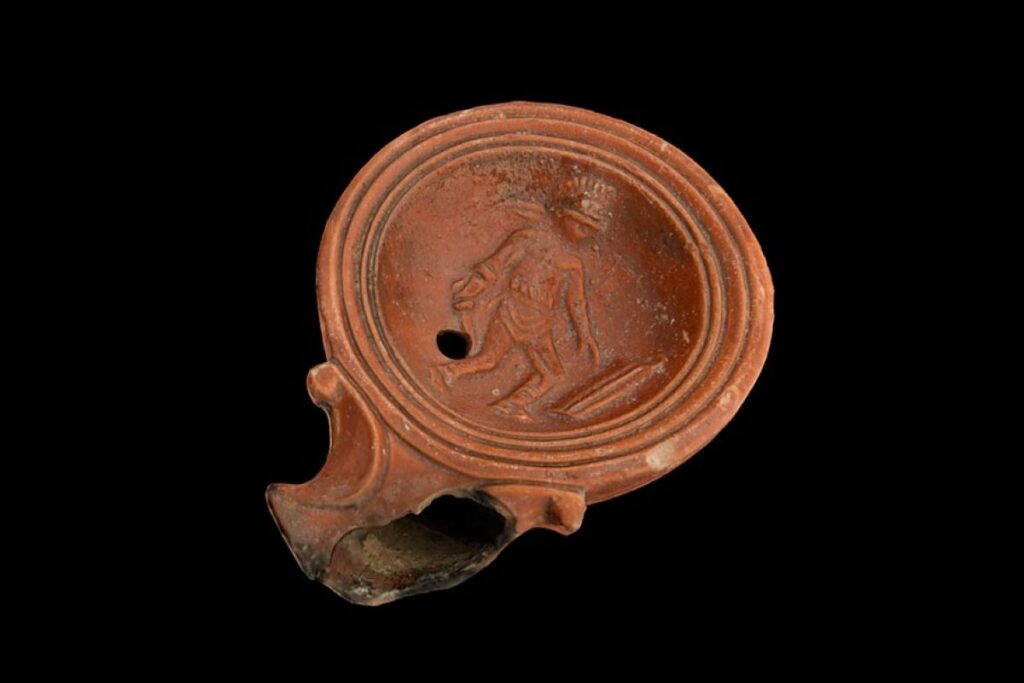Appropriately delivered at St Paul’s Catacombs—the discovery site of many ancient oil lamps—a talk recently delivered by Nigel Klemenčič-Puglisevich explored the history of Malta’s ceramic oil lamps by examining their origins, typologies, and uses from the Punic through to the Islamic periods of Maltese history and archaeology.
Though often simple in form, these small artefacts are common across Malta’s archaeological record. Each carries unique styles, symbols, and residues that speak to changing technologies, traditions, and beliefs.
Early lamps dating from the Palaeolithic and Neolithic were made of stone, often just shallow depressions to hold oil or animal fat for burning. While examples in Malta are rare, this rudimentary form marks the beginning of artificial lighting. During the Phoenician and Punic periods, more sophisticated ceramic lamps arrived from the Levant. These often had double nozzles and varied in rim shape, thickness, and size—generally becoming thinner over time. They were both domestic tools and ritual items, often found in tombs as offerings or in domestic contexts as home lighting.
In 218 BC, Malta was conquered by the Roman Republic, and around this time, a distinct local lamp form emerged: the Romano-Maltese type. Found only in Malta, this compact, functional, single-nozzle lamp was used from approximately the 2nd century BC to the 7th century AD. While similar forms existed in Sicily and Libya, none match this type’s specific features. Its uniqueness and the significant amount yielded at Maltese archaeological sites highlights Malta’s local craftsmanship within a broader imperial economy.
As Roman influence deepened, the double-nozzle style faded, replaced almost exclusively by single-nozzle types. Decorative elements increased—lions, stags, gods, and, later on, Christian symbols like fish and crosses adorned many lamps. These were not merely functional; they expressed personal belief and social identity—these would double as home decor and conversation pieces. Some lamps were even inscribed and offered at temples as gifts to gods and goddesses, such as those at Tas-Silġ or in Rabat, perhaps to deities such as Astarte, Juno, Apollo, or Proserpina.
The oil itself—whether olive, sesame, or animal fat—offers clues about trade, agriculture, and ritual. In Malta, evidence suggests olive oil was most common, supported by the presence of olive oil production sites like San Pawl Milqi, Ta’ Kaċċatura, and Bidnija.
Lamps help shine a light on Malta’s role as a cultural crossroads. Many finds are imports from North Africa, Italy, and the Levant, reflecting trade and mobility. Yet the widespread local presence of the Romano-Maltese type signals a thriving local community capable of sustaining its own ceramic production—unlike many other Roman colonies where imports dominated.
Funerary contexts provide some of the most evocative finds. Oil lamps were often placed in tombs, perhaps to light the way for the deceased or to aid the living during rituals in dark hypogea. Some are still blackened with soot from ancient use. In certain cases, soil sealed inside the lamps preserves traces of oil, helping us identify fuels and determine trade routes and agricultural practices. However, Malta’s salty soil can also degrade these artefacts if not carefully conserved.
The mass production of lamps also contributed—albeit modestly—to environmental change. Roman industry, including ceramics, relied heavily on wood for kiln fuel. By the time of Roman control, Malta was largely deforested, so kilns likely used brushwood or repurposed timber from ships. Though on a smaller scale than Roman mining, even Malta’s ceramic production likely had an environmental footprint.
By the late Roman and Byzantine periods, Christian motifs dominated. Lamps on display at St Paul’s Catacombs and the Domvs Romana bear crosses and other biblical imagery like the Chi Rho. But these eventually disappeared, replaced in the Islamic period by glazed lamps—usually green, symbol-free, and in keeping with religious tradition. These were likely imported during the Fatimid Caliphate in the 10th century, when Malta’s economy was closely tied to Egypt. Workshops near Cairo exported such lamps across the Mediterranean.
Oil lamps were practical, reusable, and more affordable than candles. They were commonly used in domestic settings like the Domvs Romana, where they lit interior spaces after dusk. Their widespread use across social settings makes them excellent indicators of daily life, trade, belief, and identity.
Though often overlooked, these small vessels reflect the rhythms of ancient life across centuries. Whether illuminating sacred rituals, guiding the dead, or brightening a humble home, oil lamps carried light—and meaning—into Malta’s past. As we continue to study and preserve them, they in turn illuminate our understanding of identity, belief, and continuity on the islands.
With thanks to Nigel Klemenčič-Puglisevich, Curator of Roman Archaeology, and Heritage Malta
